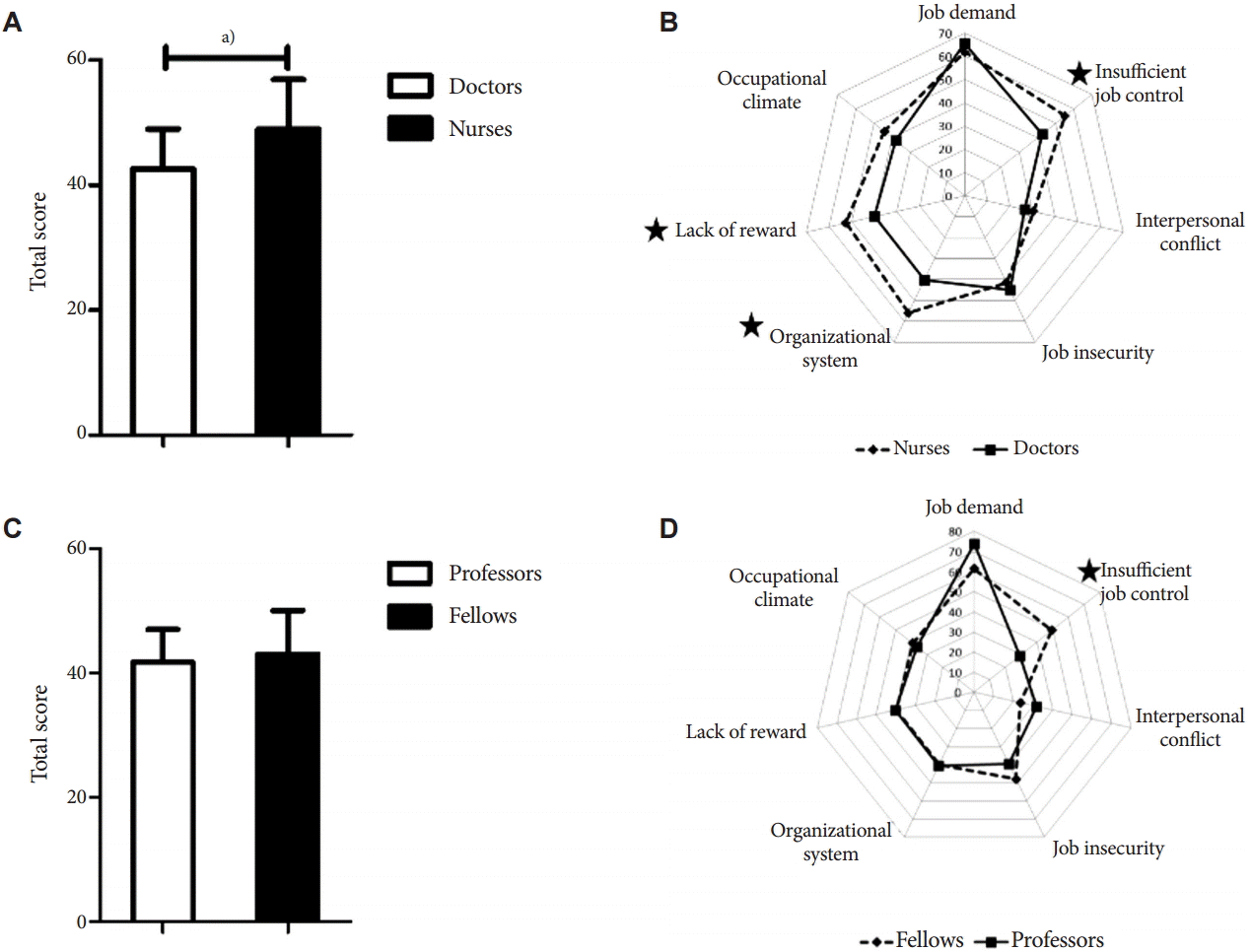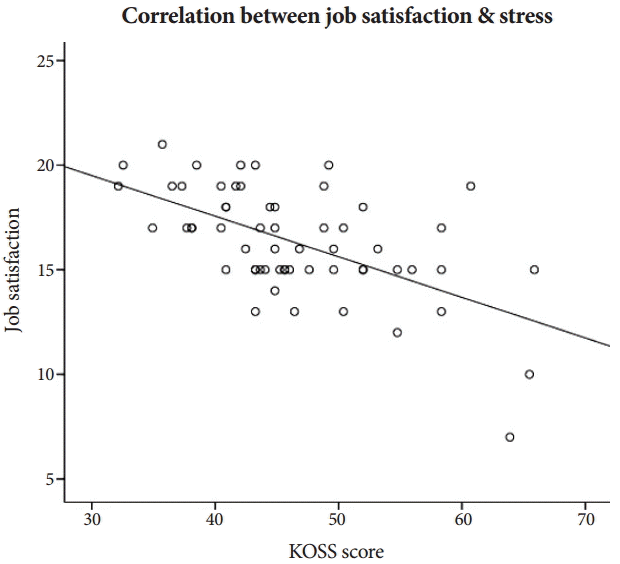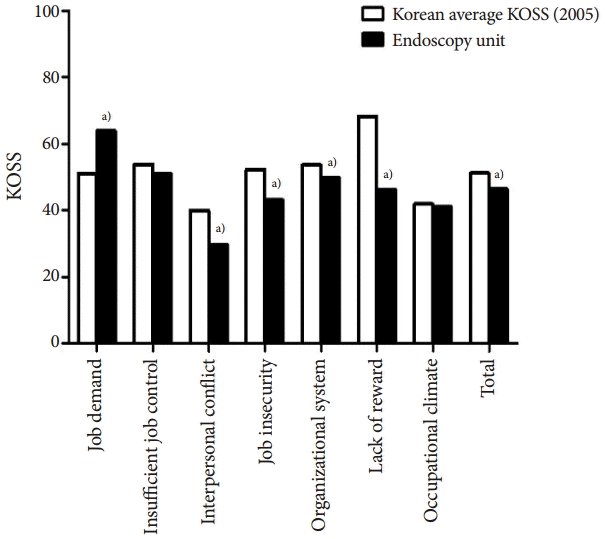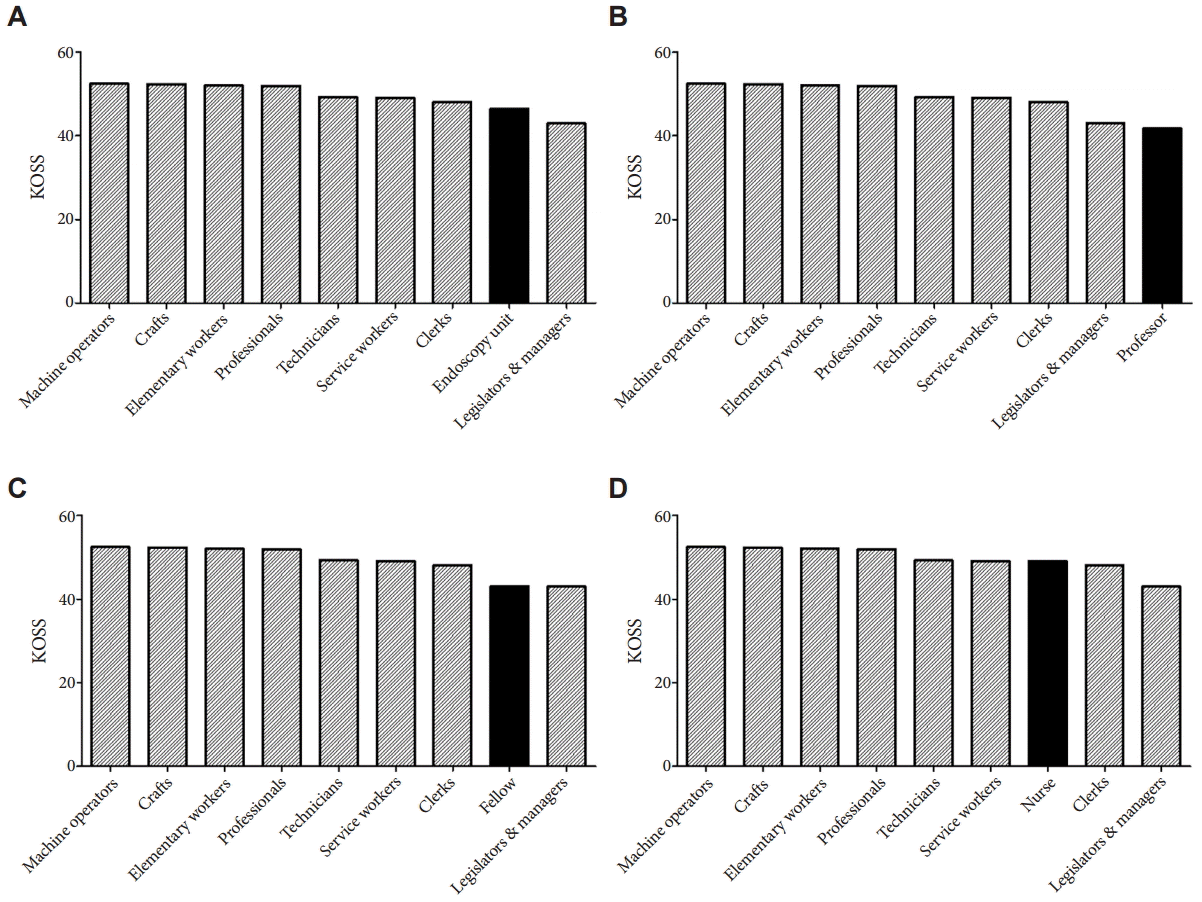Abstract
Background/Aims:
The management of job-related stress among health-care workers is critical for the improvement of healthcare services; however, there is no existing research on endoscopy unit workers as a team. Korea has a unique health-care system for endoscopy unit workers. In this study, we aimed to estimate job stress and job satisfaction among health-care providers in endoscopy units in Korea.
Methods:
We performed a cross-sectional survey of health-care providers in the endoscopy units of three university-affiliated hospitals in Korea. We analyzed the job stress levels by using the Korean occupational stress scale, contributing factors, and job satisfaction.
Results:
Fifty-nine workers completed the self-administered questionnaires. The job stress scores for the endoscopy unit workers (46.39±7.81) were relatively lower compared to those of the national sample of Korean workers (51.23±8.83). Job stress differed across job positions, with nurses showing significantly higher levels of stress (48.92±7.97) compared to doctors (42.59±6.37). Job stress and job satisfaction were negatively correlated with each other (R2=0.340, p<0.001).
Conclusions:
An endoscopy unit is composed of a heterogeneous group of health-care professionals (i.e., nurses, fellows, and professors), and job stress and job satisfaction significantly differ according to job positions. Job demand, insufficient job control, and job insecurity are the most important stressors in the endoscopy unit.
Job-related stress has been reported to have an important effect on the performance and effectiveness of workers [1,2]. In particular, the job stress experienced by health-care workers significantly affects the quality of medical services provided [3-6]. There is a great deal of research on the assessment of job stress among health-care providers, including doctors and nurses who are employed in various medical fields such as oncology, anesthesiology, and surgery [7-23]. Also, a few studies have focused on stress among gastroenterologists or nurses in the endoscopy unit [21,24]. However, there is no existing research on health-care workers in the endoscopy unit as a team. Moreover, there is no study on endoscopy unit workers in which the Korean occupational stress scale (KOSS), a validated tool for Korean workers, was used for stress assessment.
In Korea, the cost of endoscopy is low and the national health insurance service covers biennial surveillance with upper gastrointestinal endoscopy for all Korean people older than 40 years [25]. Thus, the endoscopy units in Korea have a unique stress environment compared with other medical fields, with its own set of stressors such as high patient turnover rates, abrupt changes in the patient’s vital signs during endoscopy, emergencies involving gastrointestinal bleeding or perforation, and ergonomic stresses during endoscopic procedures. Owing to these stressors, stress assessment and management for endoscopy unit workers are necessary.
In this study, we conducted a survey of job stress and job satisfaction among health-care workers of endoscopy units in Korea to aid in the efficient management of medical resources and to improve the delivery of medical services.
We surveyed doctors (professors and fellows), nurses, nurses’ assistants, and office workers in the endoscopy units of three university-affiliated hospitals in South Korea, from September to December 2013 (n=59). This study was approved by the institutional review board (no. ED14036), and all questionnaires were obtained with the consent of participants.
Self-administered questionnaires inquiring about demographic characteristics, job stress (KOSS), and job satisfaction were completed by the participants.
The KOSS was used to assess job stress. This scale was developed by Chang et al. [26] in 2003, with support from the Occupational Safety and Health Research Institute of Korea. This instrument was standardized and validated by administering it to a national sample of 12,631 employees from varied occupations in Korea, and the process of its development was reported in 2005 [26]. We used the short form of the KOSS, which is composed of seven subscales pertaining to job stress with a total of 24 items: (1) job demand (four items); (2) insufficient job control (four items); (3) interpersonal conflict (three items); (4) job insecurity (two items); (5) organizational system (four items); (6) lack of reward (three items); and (7) occupational climate (four items) (Supplementary Table 1). The total stress score was calculated by summing the scores of each subscale and by using a formula outlined by the developers. A higher score indicates more severe or a higher level of stress.
The independent variables included data on demographic characteristics such as the participants’ sex, age, marital status, religion, job position, employment duration, duty hours, income, and lifestyle. Job satisfaction was assessed by using five questions about general job satisfaction, sense of achievement, and intent to remain on the job by using a five-point Likert-type scale ranging from “strongly disagree” to “strongly agree.”
The KOSS scores among the different groups of endoscopy unit workers were compared by using Student t-test and analysis of variance. Comparisons of the participants’ KOSS scores with the scores of workers from other occupations were also performed with Student t-test. The correlations between job stress and job satisfaction were analyzed by using Pearson correlation coefficient. p-values <0.05 were considered statistically significant. Statistical analyses were performed with IBM SPSS version 20 (IBM Co., Armonk, NY, USA). The summary data are presented as mean±standard deviation (SD).
We contacted health-care providers (doctors, nurses, and nurses’ assistants) and office workers from the endoscopy units of three university-affiliated hospitals. Of the 70 workers who were given the self-administered questionnaires, 59 completed and returned them (response rate, 84%). Among them, 24 were doctors (eight professors and 16 fellows) and 34 were nurses.
The participants’ demographic characteristics and the means of their job stress and job satisfaction scores are summarized in Table 1. The scores on the KOSS were significantly different among occupations and positions. The nurses, in particular, had the highest stress scores among the endoscopy unit workers. The stress scores did not differ significantly according to lifestyle habits, such as exercise and alcohol, or coffee consumption. When we compared the stress levels between doctors (fellows and professors) and nurses, the nurses had significantly higher stress scores (KOSS: 42.59±6.37 for doctors and 48.92±7.97 for nurses) (Fig. 1A). Among the seven subscales of occupational stress, “insufficient job control,” “organizational system,” and “lack of reward” were significantly different between doctors and nurses (Fig. 1B, star). Both groups had high stress scores on the “job demand” subscale, which was also a common stress factor for all of the endoscopy unit workers, and was the distinguishing feature of the endoscopy unit workers when they were compared with persons of other occupations.
We compared the stress levels between the professors and the fellows in the doctor group. The total KOSS scores of the professors and fellows were not significantly different from each other (41.72±5.27 and 43.03±6.98, respectively) (Fig. 1C). However, a comparison of the scores on the subscales between the two groups revealed a significant difference in the insufficient job control subscale (Fig. 1D, indicated by the star).
There was a significant correlation between job satisfaction and KOSS scores (R2=0.340, p<0.001) (Fig. 2). Several subscales of the KOSS were significantly correlated with job satisfaction: insufficient job control, organizational system, lack of reward, and occupational climate (Table 2). These subscales can be considered significant components of job stress and areas of focus for the improvement of job satisfaction.
We compared the KOSS scores of the endoscopy unit workers with the scores of the national sample of Korean workers of various other occupations, to acquire a clearer understanding of the working environment in the endoscopy unit (Fig. 3) [26]. The mean of the KOSS scores of the endoscopy unit workers was 46.39±7.81, which was significantly lower than the mean of the scores of the Korean workers from the national sample (51.23±8.83); this means that endoscopy unit workers have a lower stress level than general Korean workers [26]. Among the seven subscales of KOSS, job demand was the only subscale that revealed significantly higher scores for endoscopy unit workers; the other subscales (interpersonal conflict, job insecurity, organizational system, and lack of reward) all had significantly lower scores for endoscopy unit workers than for the national sample of Korean workers (Fig. 3).
We further compared the stress scores of endoscopy unit workers with those of persons of other specific occupations, according to the Korean occupational classification system (Fig. 4). The KOSS scores for the entire group of health-care providers in endoscopy units (46.39±7.81) were relatively lower, falling between the KOSS scores of clerks (48.11±9.01) and legislators (42.96±6.71) (Fig. 4A). Because the stress scores were significantly different among endoscopy unit workers of different job positions, we separately compared the KOSS scores according to job positions with the scores of other Korean workers. Interestingly, the stress level of professors (41.72±5.27) was even lower than that of legislators and managers (42.96±6.71) (Fig. 4B). Fellows’ stress score (43.03±6.98) was somewhat higher than that of legislators and managers (42.96±6.71), but significantly lower than that of clerks (48.11±9.01) (Fig. 4C). The nurses’ stress score (49.09±7.80) approached the Korean national sample’s average (51.23±8.83), which was similar to the scores of two other groups: technicians (49.26±7.36) and service workers (49.14±7.97) (Fig. 4D). Again, we can assume that the stress level in the endoscopy unit environment was relatively lower than in other Korean occupations, and the endoscopy unit is composed of a heterogeneous group of health-care workers who can be separated according to job positions.
Health-care providers of Korean endoscopy units are working intimately with each other owing to their unique working environment. Therefore, evaluating occupational stress in a unit is important for the appropriate management of stress. This is the first study concerning the occupational stress of health-care providers in endoscopy units.
Interestingly, the mean stress level of health-care providers in endoscopy units was relatively lower than that found in Korean workers of other occupations. The most distinguishable stress characteristic for endoscopy unit workers was their significantly high stress score on the job demand subscale (Fig. 3). For doctors, the high score on the job demand subscale can be attributed to the high technical demands of advanced endoscopic procedures. Emergencies that may occur during routine surveillance endoscopy in the outpatient department can be another source of stress. For nurses and nurses’ assistants, the high scores on the job demand subscale may be attributed to high patient turnover rates, abrupt changes in the patient’s vital signs during sedative endoscopy, and ergonomic stresses during providing assistance in endoscopic procedures.
Job position was the only factor that revealed a significant difference in stress levels among endoscopy unit workers. This result suggests that the endoscopy unit is composed of a heterogeneous group of workers in terms of stress, and that a stratified approach according to job position is necessary to manage stress effectively. For nurses, insufficient job control, organizational system, and lack of rewards were the major sources of stress that must be addressed to reduce the stress level. Open discussions with the nurses about decision-making policies and fair personnel practices by the management may be possible solutions to reduce job stress. For fellows, job insecurity was significantly associated with higher levels of job stress. Efforts to provide a stable occupational environment (e.g., systematic support in finding adequate job positions for fellows completing affiliated hospital duty) could improve their sense of job security. The professors group showed a distinct result in the stress subscales: only the job demand subscale score was high, whereas the other subscale scores were very low. The occupational characteristics of professors, e.g., requiring up-to-date knowledge and discernible achievements in the field, could give rise to these results. In fact, this job component is very difficult to rectify without sacrificing personal development and achievement. However, the stress associated with the job demand in professors is also due to the large number of patients requiring attention on a daily basis. This kind of demand can be managed by reducing the hospital’s pressure on professors in terms of generating more revenue.
The stress scores can be affected by multiple factors. In addition to the factors analyzed in this study, psychological factors (e.g., personality, self-esteem, and coping strategies) may also affect stress sensitivity [27-30]. These factors were not addressed in this study and should be considered when interpreting the differences in job stress among workers of different positions (e.g., professors, fellows, and nurses). In addition, educational programs about healthy coping strategies against stressors can be another solution for reducing job stress.
This study has some limitations. The national surveillance of KOSS scores was conducted in 2005, i.e., an 8-year interval with this study. The KOSS scores can differ significantly during this term in consideration of the dynamic characteristics of the Korean society. However, these are the only validated data that can be used for comparison. That is why many recent comparative studies still use these data [16,31]. The second limitation comes from the survey method; the study population consisted of employees of the institution where the study was done. However, this study was performed anonymously and privately with the consent of participants, and the results were sealed and sent to the blinded investigator for the analysis, thus minimizing inaccurate responses, similar to other studies [32].
Recently, quality improvement has been considered a major topic in the medical profession. The improvement of technical methods and medical instruments, which are costly expenditures for hospitals, are usually highlighted as quality improvement activities. On the contrary, job stress assessment and management have been easily overlooked, although these factors are critical aspects for quality improvement. In addition, job stress and satisfaction scores can be indicators of the quality of the hospital’s health-care system [9,33]. In this regard, regular evaluations of occupational stress among endoscopy unit workers must be given priority, and strategies to address the findings from the evaluations must be implemented to promote quality improvement.
Supplementary Materials
Supplementary materials are available at http://dx.doi.org/10.5946/ce.2015.085 or via http://e-ce.org/.
REFERENCES
3. West CP, Tan AD, Habermann TM, Sloan JA, Shanafelt TD. Association of resident fatigue and distress with perceived medical errors. JAMA. 2009; 302:1294–1300.

4. Dyrbye LN, Massie FS Jr, Eacker A, et al. Relationship between burnout and professional conduct and attitudes among US medical students. JAMA. 2010; 304:1173–1180.

5. Shanafelt TD, Balch CM, Bechamps G, et al. Burnout and medical errors among American surgeons. Ann Surg. 2010; 251:995–1000.

6. Shanafelt TD, Bradley KA, Wipf JE, Back AL. Burnout and self-reported patient care in an internal medicine residency program. Ann Intern Med. 2002; 136:358–367.

7. Shanafelt T, Dyrbye L. Oncologist burnout: causes, consequences, and responses. J Clin Oncol. 2012; 30:1235–1241.

8. McDonnell NJ, Kaye RM, Hood S, Shrivastava P, Khursandi DC. Mental health and welfare in Australian anaesthetists. Anaesth Intensive Care. 2013; 41:641–647.

9. Voltmer E, Rosta J, Siegrist J, Aasland OG. Job stress and job satisfaction of physicians in private practice: comparison of German and Norwegian physicians. Int Arch Occup Environ Health. 2012; 85:819–828.

10. Walsh J. Gender, the work-life interface and wellbeing: a study of hospital doctors. Gend Work Organ. 2013; 20:439–453.

11. Bauer J, Groneberg DA. Stress and job satisfaction in the discipline of inpatient anesthesiology: results of a web-based survey. Anaesthesist. 2014; 63:32–40.
12. Yoon SL, Kim JH. Job-related stress, emotional labor, and depressive symptoms among Korean nurses. J Nurs Scholarsh. 2013; 45:169–176.

13. van Beuzekom M, Akerboom S, Boer F, Dahan A. Influence of latent risk factors on job satisfaction, job stress and intention to leave in anaesthesia teams: a cross-sectional survey. Eur J Anaesthesiol. 2013; 30:222–228.
14. Saijo Y, Chiba S, Yoshioka E, et al. Job stress and burnout among urban and rural hospital physicians in Japan. Aust J Rural Health. 2013; 21:225–231.

15. Løvseth LT, Fridner A, Jónsdóttir LS, Marini M, Linaker OM. Associations between confidentiality requirements, support seeking and burn-out among university hospital physicians in Norway, Sweden, Iceland and Italy (the HOUPE study). Stress Health. 2013; 29:432–437.

16. Kang SH, Boo YJ, Lee JS, Ji WB, Yoo BE, You JY. Analysis of the occupational stress of Korean surgeons: a pilot study. J Korean Surg Soc. 2013; 84:261–266.

17. Jones MC, Wells M, Gao C, Cassidy B, Davie J. Work stress and well-being in oncology settings: a multidisciplinary study of health care professionals. Psychooncology. 2013; 22:46–53.

18. Iliceto P, Pompili M, Spencer-Thomas S, et al. Occupational stress and psychopathology in health professionals: an explorative study with the multiple indicators multiple causes (MIMIC) model approach. Stress. 2013; 16:143–152.

19. Gramstad TO, Gjestad R, Haver B. Personality traits predict job stress, depression and anxiety among junior physicians. BMC Med Educ. 2013; 13:150.

20. Fiabane E, Giorgi I, Musian D, Sguazzin C, Argentero P. Occupational stress and job satisfaction of healthcare staff in rehabilitation units. Med Lav. 2012; 103:482–492.
21. Keswani RN, Taft TH, Coté GA, Keefer L. Increased levels of stress and burnout are related to decreased physician experience and to interventional gastroenterology career choice: findings from a US survey of endoscopists. Am J Gastroenterol. 2011; 106:1734–1740.

22. Fujimura Y, Tanii H, Saijoh K. Inpatient satisfaction and job satisfaction/stress of medical workers in a hospital with the 7:1 nursing care system (in which 1 nurse cares for 7 patients at a time). Environ Health Prev Med. 2011; 16:113–122.

23. Sehlen S, Vordermark D, Schäfer C, et al. Job stress and job satisfaction of physicians, radiographers, nurses and physicists working in radiotherapy: a multicenter analysis by the DEGRO Quality of Life Work Group. Radiat Oncol. 2009; 4:6.

24. Son SS, Yang SJ. Job stress and job satisfaction among nurses in gastrointestinal endoscopy units. J Korean Clin Nurs Res. 2014; 20:189–199.
25. Choi IJ. Endoscopic gastric cancer screening and surveillance in high-risk groups. Clin Endosc. 2014; 47:497–503.

26. Chang SJ, Koh SB, Kang D, et al. Developing an occupational stress scale for Korean employees. Korean J Occup Environ Med. 2005; 17:297–317.
27. Kjeldmand D, Holmström I. Balint groups as a means to increase job satisfaction and prevent burnout among general practitioners. Ann Fam Med. 2008; 6:138–145.

28. Soler JK, Yaman H, Esteva M, et al. Burnout in European family doctors: the EGPRN study. Fam Pract. 2008; 25:245–265.

29. Tattersall AJ, Bennett P, Pugh S. Stress and coping in hospital doctors. Stress Med. 1999; 15:109–113.

30. Deckard G, Meterko M, Field D. Physician burnout: an examination of personal, professional, and organizational relationships. Med Care. 1994; 32:745–754.

31. Song IW, Woo KH, Kim JS, et al. Occupational factors associated with changes in the body mass index of korean male manual workers. Ann Occup Environ Med. 2013; 25:40.

Fig. 1.
Comparison of job stress among different occupations and positions. (A, B) Nurses showed significantly higher levels of stress than doctors did. Each bar graph represents mean (SD). The radar chart for the seven subscales of the Korean occupational stress scale (KOSS) showed the stress character for each group. Significantly different subscales are marked with stars (p<0.05). (C, D) When the doctors group was analyzed further according to positions, there was no significant difference in the KOSS scores between professors and fellows. Each bar graph represents mean (SD). The radar chart for the seven subscales of the KOSS showed that “insufficient job control” was the only different subscale between these two groups. Significant differences between the subscales are marked with stars (p<0.05). a)p<0.01.

Fig. 2.
Correlations between job satisfaction and job stress in endoscopy unit workers. Pearson’s correlation analysis revealed a significant negative correlation between job satisfaction and Korean occupational stress scale (KOSS) scores (R2=0.340, p<0.001).

Fig. 3.
Comparison of the Korean occupational stress scale (KOSS) scores of endoscopy unit workers with the scores of the national sample of Korean workers. a)Significantly different subscales p<0.05.

Fig. 4.
Comparison of the Korean occupational stress scale (KOSS) scores of endoscopy unit workers with the scores of persons of other occupations, according to the Korean Standard Classification of Occupations. (A) The KOSS scores of all health-care providers in the endoscopy units fell between the KOSS scores of clerks and those of legislators. (B) The KOSS scores of professors in the endoscopy units were even lower than the KOSS scores of legislators and managers, which were the groups showing the lowest scores among all other Korean occupations. (C) The KOSS scores of fellows were slightly higher compared to those of legislators and managers but significantly lower than those of clerks. (D) The KOSS scores of the nurses were very close to the KOSS scores of the Korean national sample and similar to the KOSS scores of technicians and service workers.

Table 1.
Participants’ Characteristics, Mean±SD on the Korean Occupational Stress Scale and Job Satisfaction Questionnaire
Table 2.
Correlations between Job Satisfaction and Job Stress according to the Korean Occupational Stress Scale Subscales




 PDF
PDF Citation
Citation Print
Print


 XML Download
XML Download